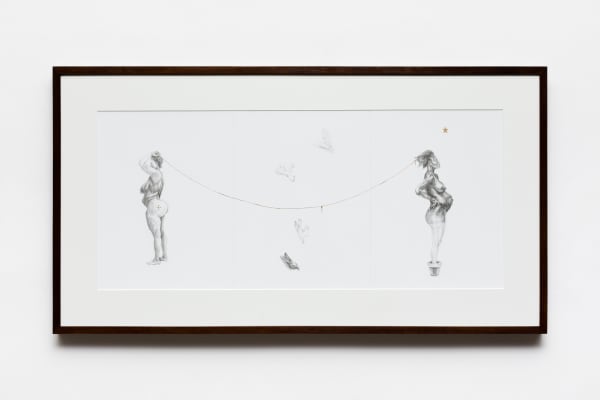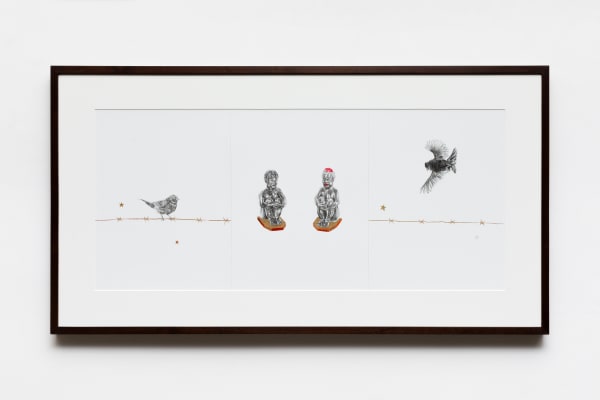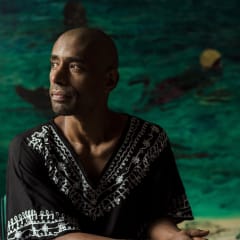Signo Antonio Obá
Past exhibition
Overview
Antonio Obá considers the drawing as a living thought. The artist returns to the São Paulo venue with an exhibition devoted exclusively to his works on paper - "an exercise in letting language emerge," according to Obá. The use of drawing, recurrent in his work and also in his relationship with painting, echoes a more intuitive moment for the artist - a living thought that takes shape as it is conceived.
For Obá, drawing and painting share the same starting point - what emerges is the body assigned to each moment. The drawings are the result of a faster, more automatic process, however, this does not exclude the essence of surprise that is inherent in his narrative. The artist shapes a dialog that embraces a whole pantheon of references - the symbiosis that brings forth his compositions. This process meets two variants: Drawings that require a slow-paced construct and greater formal dexterity, executed in graphite and finished with gold Chinese ink, and rough drawings that incorporate a cathartic movement in their making.
Concerning his most refined drawings, Obá draws on a glance recurrent in his artwork: the idea of reinventing memory, that is, of a subject who upends - and manipulates - his position. In the work Outros ofícios: Liteira, whose name refers to the sedan chair in which the enslaved people carried the masters, the artist resorts to the depiction of a child, also commonplace in his works, as a way of emphasizing the origins, the playful - the amusement as a means of learning how to ward off the fearful, the huge. The drawing alludes to hunting practices by placing the children in a symbolic game where individuals regain power.
Moreover, the drawings convey a somewhat ironic response to this part of labor, toil, and exploitation. By evoking images of enslaved people in barbershop settings, Obá refers to a whole series of epochal instruments, devising a symbolism in which the hand that creates is also the hand that transforms matter. The cape of the barber, which resembles a clerical cloak, suggests the perception of nobility that comes from the métier, the work. In addition, the drawing bears the junction of religious elements, another structural feature in Obá's work that alludes to the beheading of Saint John the Baptist, a scene very familiar to the collective imagination. For the artist, pain is also an element of consecration.
Such ironic revisionism sets Obá's work on an ongoing expansion, pushing aside the delimited notion of historicity within his artworks. His creations allow for the unfolding of interpretations - that thrive both at large and as many. In Sign, the artist contrives the images in an almost iconographic manner, in which the illustrations are all interwoven and form a narrative with diverse possibilities.
The works on paper take all this symbolic weight and explore the spatial dynamics and breaths of negative spaces. In them, Obá equalizes an assembling factor that nearly resonates with a desire for a more stable equilibrium, as in the case of the central figure that counterpoises two heads as a means of being established in the world.
As for the rough drawings, Obá is committed to a kind of writing - or, as he says, a living register. These are more ritualistic scenes, applied with the quill pen in Aqualine watercolor, which comes closer to an aura of intimacy disclosed by the artist. The bodies reveal moments of pain and consecration as they are supposed to be: free of their burden, of any mantle or armor. The drawing encounters its quintessential nature - liberation, and catharsis.
For Obá, drawing and painting share the same starting point - what emerges is the body assigned to each moment. The drawings are the result of a faster, more automatic process, however, this does not exclude the essence of surprise that is inherent in his narrative. The artist shapes a dialog that embraces a whole pantheon of references - the symbiosis that brings forth his compositions. This process meets two variants: Drawings that require a slow-paced construct and greater formal dexterity, executed in graphite and finished with gold Chinese ink, and rough drawings that incorporate a cathartic movement in their making.
Concerning his most refined drawings, Obá draws on a glance recurrent in his artwork: the idea of reinventing memory, that is, of a subject who upends - and manipulates - his position. In the work Outros ofícios: Liteira, whose name refers to the sedan chair in which the enslaved people carried the masters, the artist resorts to the depiction of a child, also commonplace in his works, as a way of emphasizing the origins, the playful - the amusement as a means of learning how to ward off the fearful, the huge. The drawing alludes to hunting practices by placing the children in a symbolic game where individuals regain power.
Moreover, the drawings convey a somewhat ironic response to this part of labor, toil, and exploitation. By evoking images of enslaved people in barbershop settings, Obá refers to a whole series of epochal instruments, devising a symbolism in which the hand that creates is also the hand that transforms matter. The cape of the barber, which resembles a clerical cloak, suggests the perception of nobility that comes from the métier, the work. In addition, the drawing bears the junction of religious elements, another structural feature in Obá's work that alludes to the beheading of Saint John the Baptist, a scene very familiar to the collective imagination. For the artist, pain is also an element of consecration.
Such ironic revisionism sets Obá's work on an ongoing expansion, pushing aside the delimited notion of historicity within his artworks. His creations allow for the unfolding of interpretations - that thrive both at large and as many. In Sign, the artist contrives the images in an almost iconographic manner, in which the illustrations are all interwoven and form a narrative with diverse possibilities.
The works on paper take all this symbolic weight and explore the spatial dynamics and breaths of negative spaces. In them, Obá equalizes an assembling factor that nearly resonates with a desire for a more stable equilibrium, as in the case of the central figure that counterpoises two heads as a means of being established in the world.
As for the rough drawings, Obá is committed to a kind of writing - or, as he says, a living register. These are more ritualistic scenes, applied with the quill pen in Aqualine watercolor, which comes closer to an aura of intimacy disclosed by the artist. The bodies reveal moments of pain and consecration as they are supposed to be: free of their burden, of any mantle or armor. The drawing encounters its quintessential nature - liberation, and catharsis.
Works
-
 Antonio Obá, Anima, 2023
Antonio Obá, Anima, 2023 -
 Antonio Obá, Animus, 2023
Antonio Obá, Animus, 2023 -
 Antonio Obá, Ave, palavra - o enforcado, 2023
Antonio Obá, Ave, palavra - o enforcado, 2023 -
 Antonio Obá, Breve comentário sobre fazer cabeças: Figura com esmoler e orbe Exercícios de reparação, 2023
Antonio Obá, Breve comentário sobre fazer cabeças: Figura com esmoler e orbe Exercícios de reparação, 2023 -
 Antonio Obá, Esboço para uma personagem dantesca, 2023
Antonio Obá, Esboço para uma personagem dantesca, 2023 -
 Antonio Obá, Esfinge, 2023
Antonio Obá, Esfinge, 2023 -
 Antonio Obá, Exercícios de reparação: figura no balanço, 2023
Antonio Obá, Exercícios de reparação: figura no balanço, 2023 -
 Antonio Obá, Genealogia - breve comentário para o livro dos milagres, 2023
Antonio Obá, Genealogia - breve comentário para o livro dos milagres, 2023 -
 Antonio Obá, Lepisma, 2023
Antonio Obá, Lepisma, 2023 -
 Antonio Obá, Mater, 2023
Antonio Obá, Mater, 2023 -
 Antonio Obá, Oferenda, 2023
Antonio Obá, Oferenda, 2023 -
 Antonio Obá, Outros ofícios - Breve comentário sobre fazer a cabeça, 2023
Antonio Obá, Outros ofícios - Breve comentário sobre fazer a cabeça, 2023 -
 Antonio Obá, Outros ofícios: Liteira, 2023
Antonio Obá, Outros ofícios: Liteira, 2023 -
 Antonio Obá, Tiziu: papo de “passarim", 2023
Antonio Obá, Tiziu: papo de “passarim", 2023 -
 Antonio Obá, Um apaixonado, 2023
Antonio Obá, Um apaixonado, 2023 -
 Antonio Obá, Untitled/ Sem título, 2023
Antonio Obá, Untitled/ Sem título, 2023
Installation Views


















